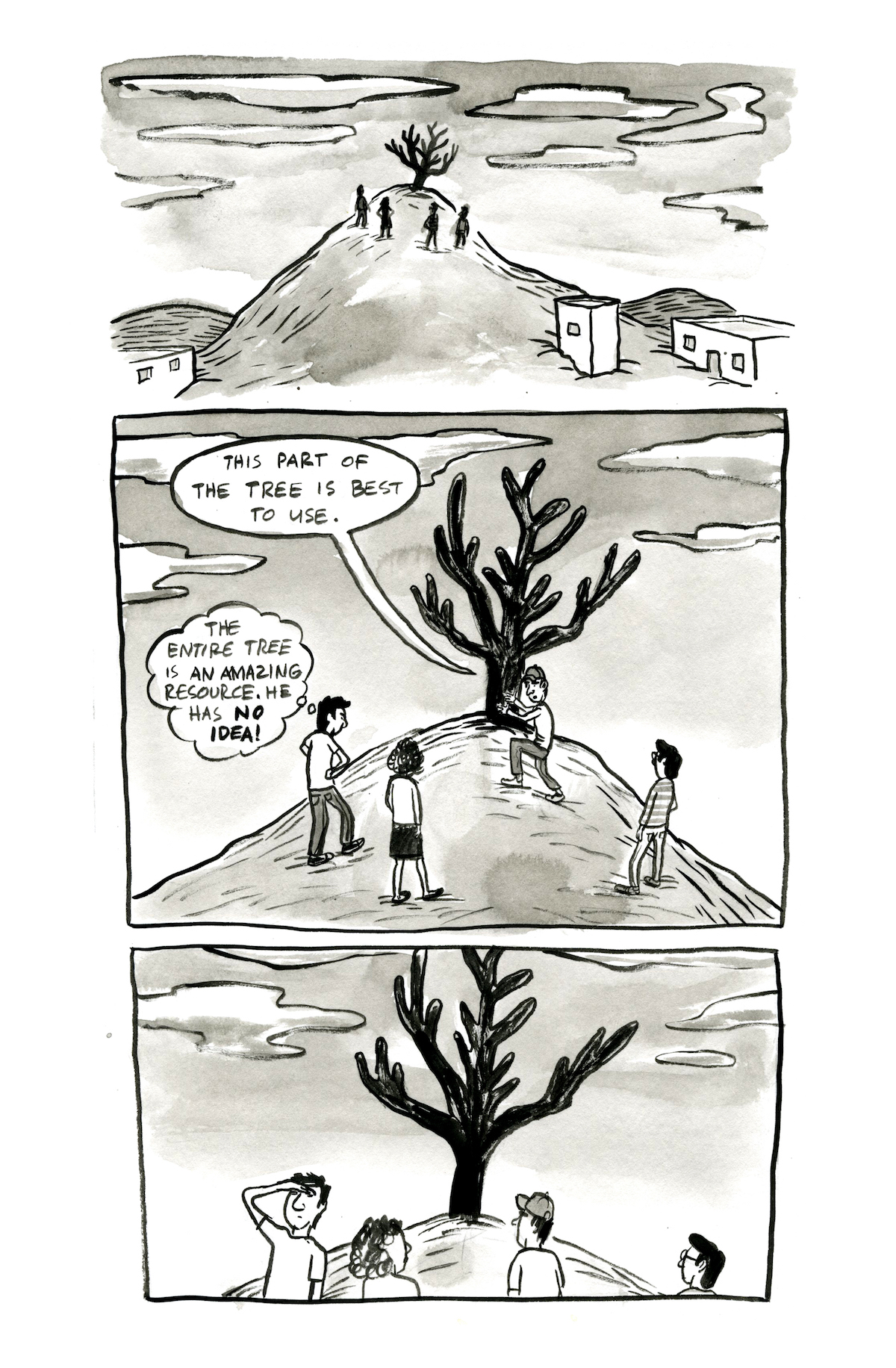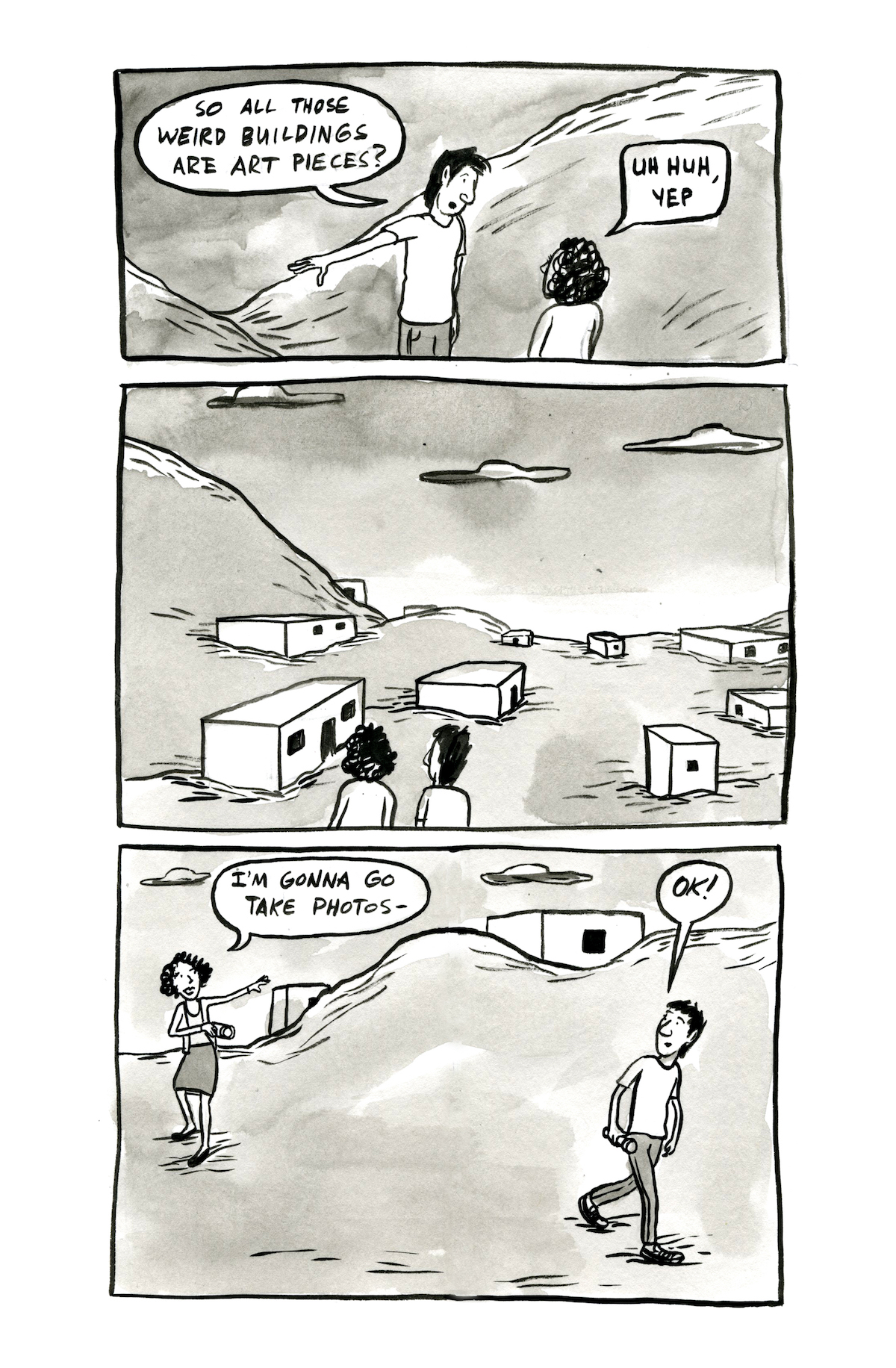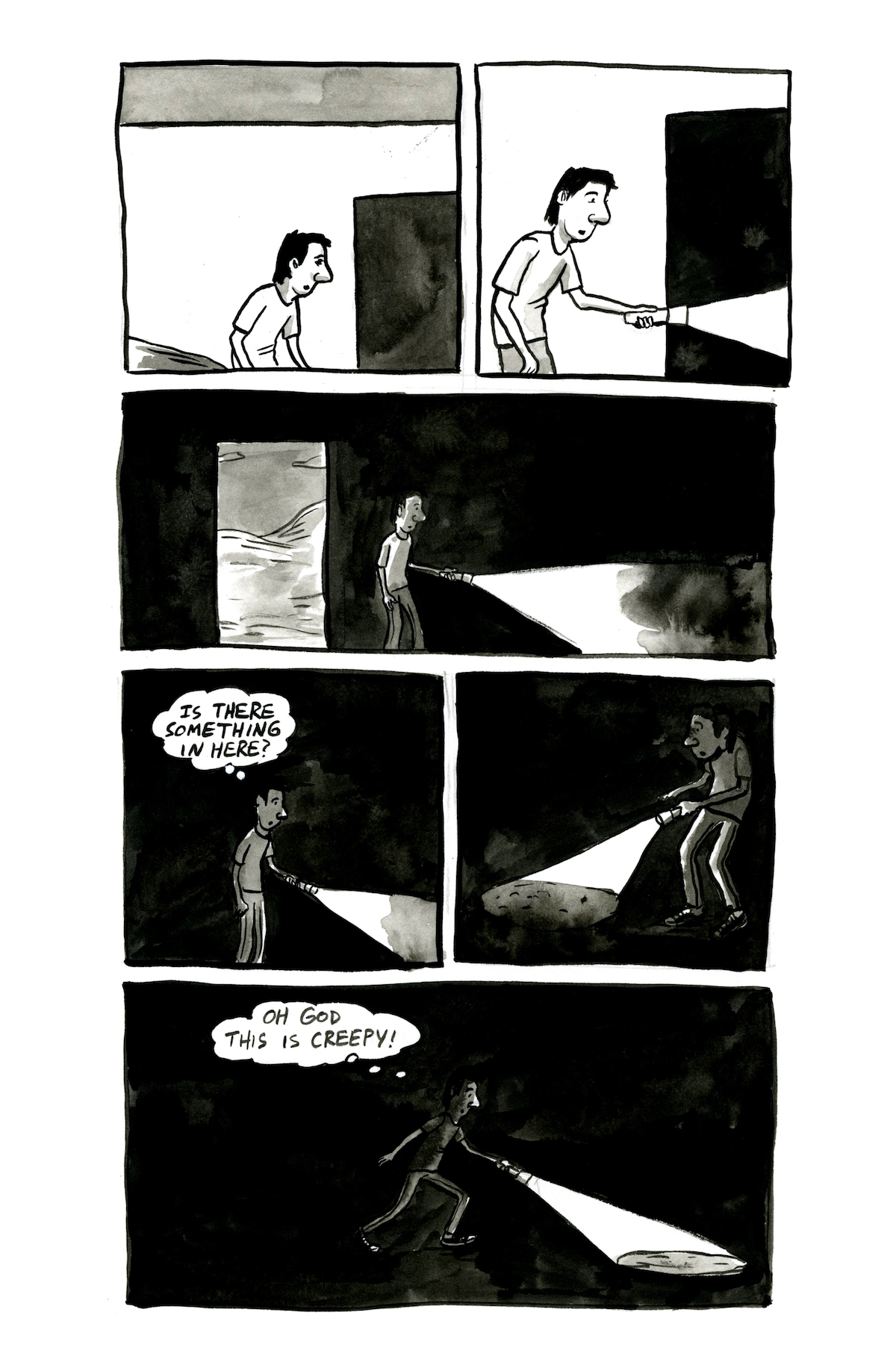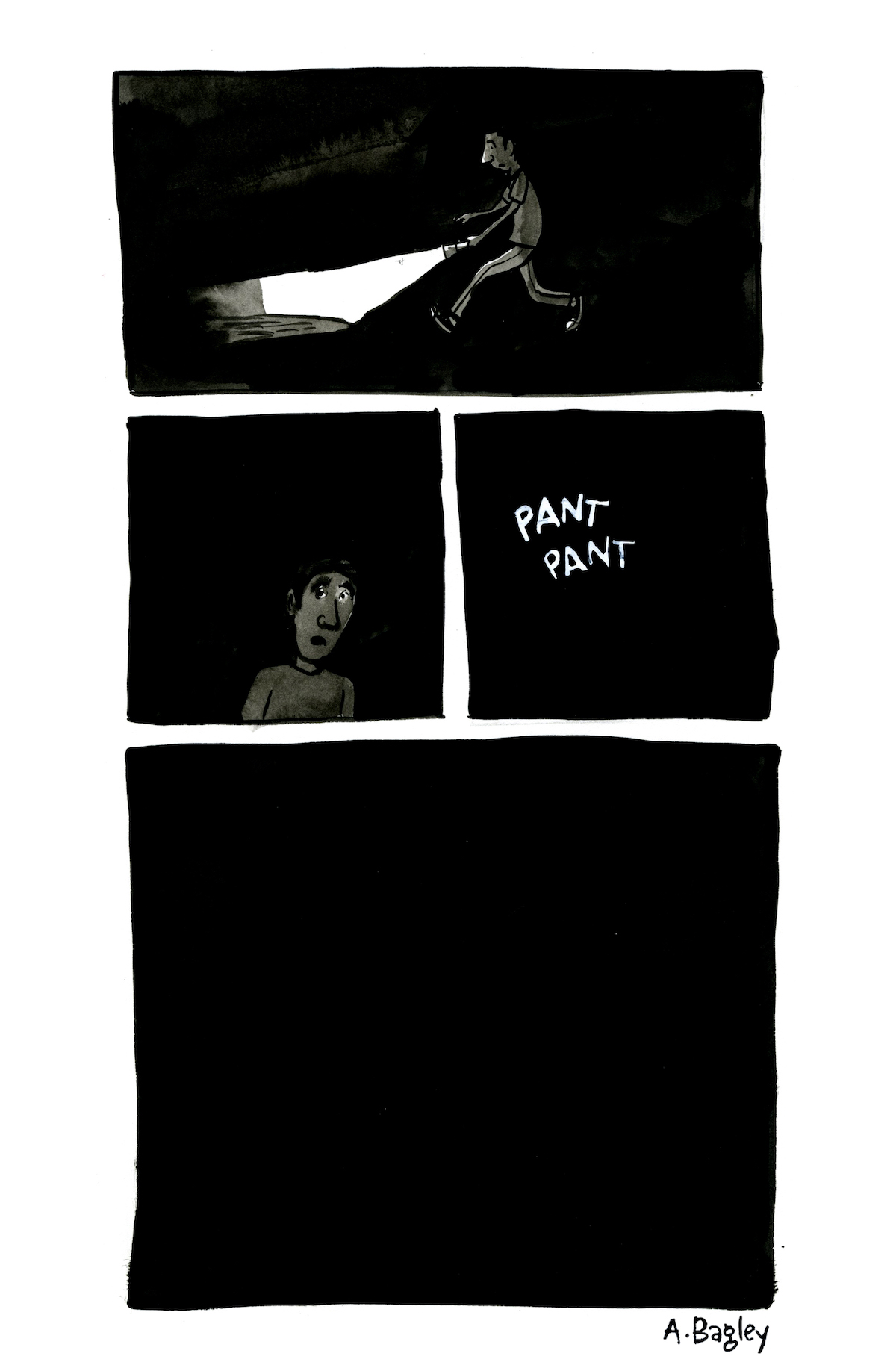The Sunday Post for March 25, 2018
Each week, the Sunday Post highlights a few articles we enjoyed this week, good for consumption over a cup of coffee (or tea, if that’s your pleasure). Settle in for a while; we saved you a seat. You can also look through the archives.
The Time for Art Is Now
"In these relentlessly dark and riven times, I find myself beset by a near ravenous hunger for beauty." So starts Claire Messud's necessary call for art in the Paris Review. It brought to mind that famous mis-attributed Emma Goldman quote about how she wouldn't join a revolution that didn't feature dancing. What she really said was: "I did not believe that a Cause which stood for a beautiful ideal, for anarchism, for release and freedom from convention and prejudice, should demand the denial of life and joy. I insisted that our Cause could not expect me to become a nun and that the movement would not be turned into a cloister. If it meant that, I did not want it. 'I want freedom, the right to self-expression, everybody's right to beautiful, radiant things.' Anarchism meant that to me, and I would live it in spite of the whole world — prisons, persecution, everything. Yes, even in spite of the condemnation of my own closest comrades I would live my beautiful ideal."
Messud points to the difference between engaged art and passive art in this quote:
But where might we find joy? Joy lies in immaterial superfluity. I find it in the long hours spent reading a book. I make this suggestion advisedly: to watch a film or a video is not the same satisfaction; when reading a book you create, for yourself, from marks upon a page, an entire, vivid interior world. You are spurred, of course, by the author, but in its particulars uniquely and fully your own. Or you might find it in communing with a painting, sculpture, or installation until you feel you’re part of it, or it is part of you. Or in lying in a summer field looking up at the dusk sky unfolding from palest pink to indigo, the awakening of the stars. Or in what Christopher Hitchens used to call “the ruined table”—the afternoon or evening lost in eager conversation long after the meal is finished, best enjoyed surrounded by empty bottles, dirty plates, and crumbs. Or in an afternoon ramble without direction or a timepiece, or in an evening spent listening to music—any music, anywhere.
Reader Discretion Advised
Claire Luchette explores profanity in poetry, and, thankfully, doesn't talk about any fucking plums or who took the goddammn things from that fuckstain of an icebox.
She also talks to Maggie Smith about her viral poem "Good Bones" (which Kelli Russell Agodon explored for us as well).
At first, fuck is only phonemes. To the uninitiated, the word is no more than the sum of its linguistic parts: a fricative, a schwa, a velar stop. Fuck’s real power lies in its transgressiveness. It’s a dirty word, but a versatile one: noun, verb, adjective, adverb, a sui generis part of speech altogether. Fuck is profane. In some circles, it’s also sacrilege, almost on par with the smut that gets a person eternally damned. And so fuck becomes fun. A provocation, a taboo.
Good-bye, Portlandia. Good-bye, Hipsters.
Ignore the headline, but do investigate this article (with graphs!) about the why, and when, of the word hipster dissapearing. Was it a vast conspiracy? Follow the graphs, detective. You may find the answer illuminating.
If you want a thorough timeline of the rise of hipster comedy, you can read one of my two articles on the subject — one, two — but it would be useful to do a quick refresher. Even though we’ve lived through the hipster era, it’s easy to forget how far back the word goes. It’s been flopping around on and off since the 1940s, when it was used to describe mostly white jazz fans, but it wasn’t until the turn of the Willenium that we started seeing it aimed generally at who we associate the term with. The first New York Magazine reference I can find is from a 2002 article about the rise of crack use in Williamsburg, which is very funny. In general, around this time you saw the word popping up more and more in major city magazines and alt weeklies. The term started tip-toeing into the mainstream in 2003, when two books came out that presented themselves as a sort of Young Hipster’s Almanac — Robert Lanham’s The Hipster Handbook and Josh Aiello’s A Field Guide to the Urban Hipster. In 2006 and 2007, partly because of technological invention, hipsters start getting used more and more as punch lines in web videos, like “Hipster Olympics.” A couple years later, there was an explosion of generic hipster sketches, mostly on YouTube, which just looked for “novel” ways to run through the same ten or so clichés
The Left-Handed Kid
A review, by Jamie Fisher, of The Chinese Typewriter: A History, by Thomas S Mullaney. The book looks great, but the review covers just why a Chinese character typewriter is such a difficult problem, and how one might go about solving it.
Unlike moveable type, which developed in China earlier and independently of the West, the typewriter has always been a foreign import. As such, its most successful inventors have tended to be boundary-walkers themselves, versed in both cultures if not entirely fluent in both scripts. The first machine marketed as a ‘Chinese typewriter’ was invented in 1888 by the American missionary Devello Sheffield, his goal less to create a typewriter than to replace the missionary’s intermediary, the opinionated Chinese clerk. ‘They usually talk to their writer,’ Sheffield wrote, ‘and he takes down with a pen what has been said, and later puts their work into Chinese literary style … The finished product will be found to have lost in this process no slight proportion of what the writer wished to say, and to have taken on quite as large a proportion of what the Chinese assistant contributed to the thought.’
Whatcha Reading, Kory Stamper?
Every week we ask an interesting figure what they're digging into. Have ideas who we should reach out to? Let it fly: info@seattlereviewofbooks.com. Want to read more? Check out the archives.
Kory Stamper is a lexographer, who worked for the Merriam-Webster family of dictionaries for twenty years. Her first book, Word by Word: The Secret Life of Dictionaries is just out in paperback. Town Hall is bringing her to Seattle this Sunday, March 25, at the Campion Ballroom on the Seattle Univeristy campus.
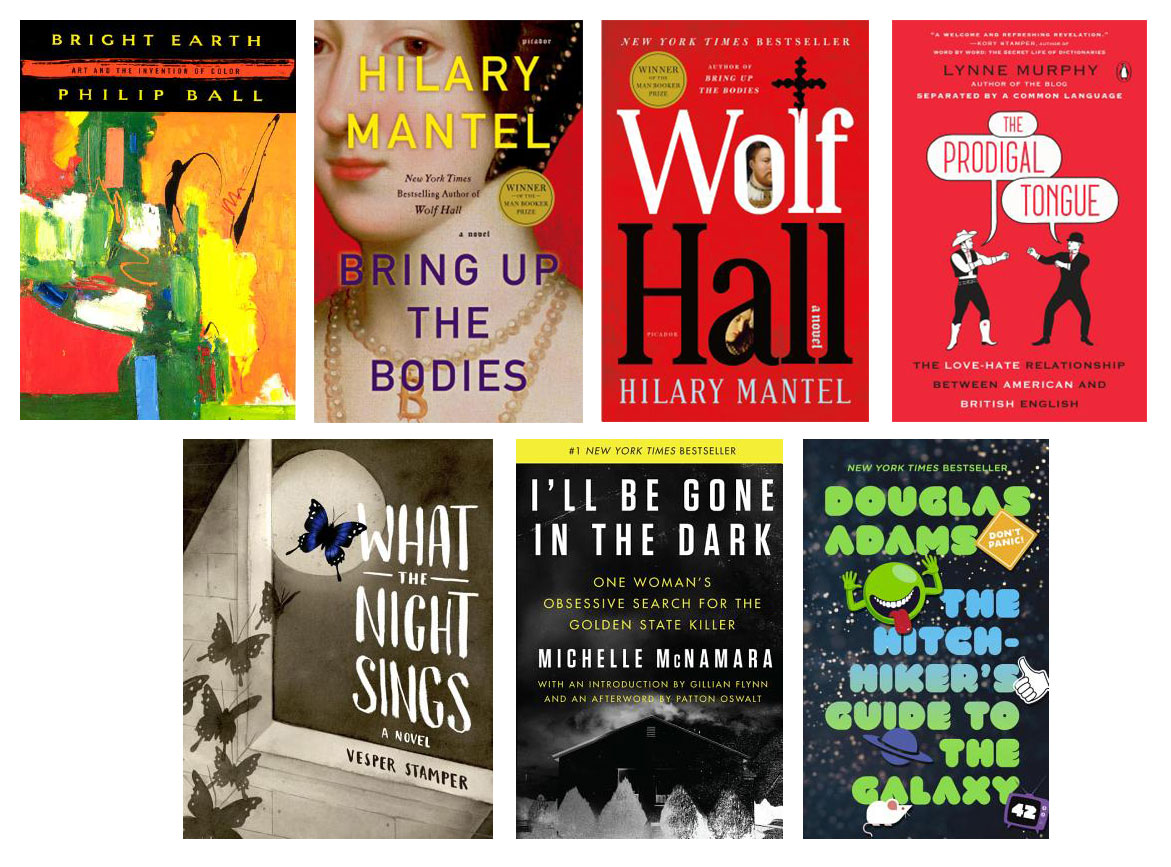
What are you reading now?
I usually have a couple of books running at once, because that's just the sort of nerd I am. My major reading is work-related: right now it's Bright Earth by Philip Ball. I'm working on another nonfiction book about color, and Ball's book is a readable and engaging book on the complexities of color by a different kind of specialist. To clear out the brainpan before bed so I can actually sleep and not bolt awake at 3:00am thinking about the color orange, I re-read a few pages of either Wolf Hall or Bring Up The Bodies by Hilary Mantel. When I first got the books, I devoured them — I think I read Bring Up The Bodies in one sitting. The characters are familiar but painted in such sympathetic detail, and the writing has such a lovely texture and rhythm and playfulness to it. I re-read books like that before bed because they usually draw me in enough that I'm not trying to fall asleep while thinking about prisms and what "magenta" really means.
What did you read last?
This is going to be the nerdiest answer you've likely ever received. For work, I read a series of monographs on colorimetry (the science of measuring the visible color spectrum) by Deane B. Judd, mostly written in the 1950s and 1960s. Even though I'm no kind of scientist, there were some fascinating tidbits in there about these amazing advances science had made in the accurate wavelength measurement of color juxtaposed with the reality that, in some cases, nothing beats the human eye for perception. It makes a non-scientist like me realize just how much of the human is involved in something I assume is wholly clinical, technical.
I also just finished reading Lynne Murphy's The Prodigal Tongue, a book about the differences between British and American English. The way she delves into it is so refreshing and is generally free of the sort of finger-wagging language shaming or chest-thumping defensiveness you see from both nations when the subject comes up.
What are you reading next?
I have spent — no joke — days trying to figure this out. Most people have a "to read" pile at home; I have a "to read" bookshelf and about six pages of "to read" suggestions, most of them marked with a star or exclamation point to remind myself that I really want to read this.
First up will be the new YA novel by my sister-in-law, Vesper Stamper: What The Night Sings. It's a gorgeously illustrated story about Holocaust survivors after the war, and I've been waiting for the right time to binge-read it. Another book I have recently added to that list is Michelle McNamara's I'll Be Gone In The Dark; the double-obsession narrative really intrigues me. I've also got some journal articles about gender and science on my work-to-read list. And I will probably cycle out the Mantel books as bedtime reading and cycle in Douglas Adams' Hitchhiker's Guide to the Galaxy. Everything's better when it ends with some Douglas Adams.
The Help Desk: A poem for the lonely
Every Friday, Cienna Madrid offers solutions to life’s most vexing literary problems. Do you need a book recommendation to send your worst cousin on her birthday? Is it okay to read erotica on public transit? Cienna can help. Send your questions to advice@seattlereviewofbooks.com.
Dear Cienna,
Will you please write me a poem?
Signed,
Lonely in Longview
Dear Lonely,
Have you considered investing in a companion? You could test the waters with a worm farm or jump whole hog into something more leggy, like a dachshund. I do not recommend spiders for beginners. They demand a taxing amount of eye contact.
Unfortunately, I don't write poetry unless it's in threat form. (I read on a bathroom stall that law enforcement have a difficult time distinguishing credible threats from art if they rhyme.) But my mother once wrote a lovely poem about friendship that may speak to your heart:
I have my puppy sitting here
Very close, I love him dear
Too bad that he's been dead a year.
He's kind of cold and stiff to touch
He's cheap to feed – he don't eat much.
I have to go, no time to talk
It's time to drag him for his walk.
Kisses,
Cienna
Portrait Gallery: Spelling Bee
Each week, Christine Larsen creates a new portrait of an author for us. Have any favorites you’d love to see immortalized? Let us know
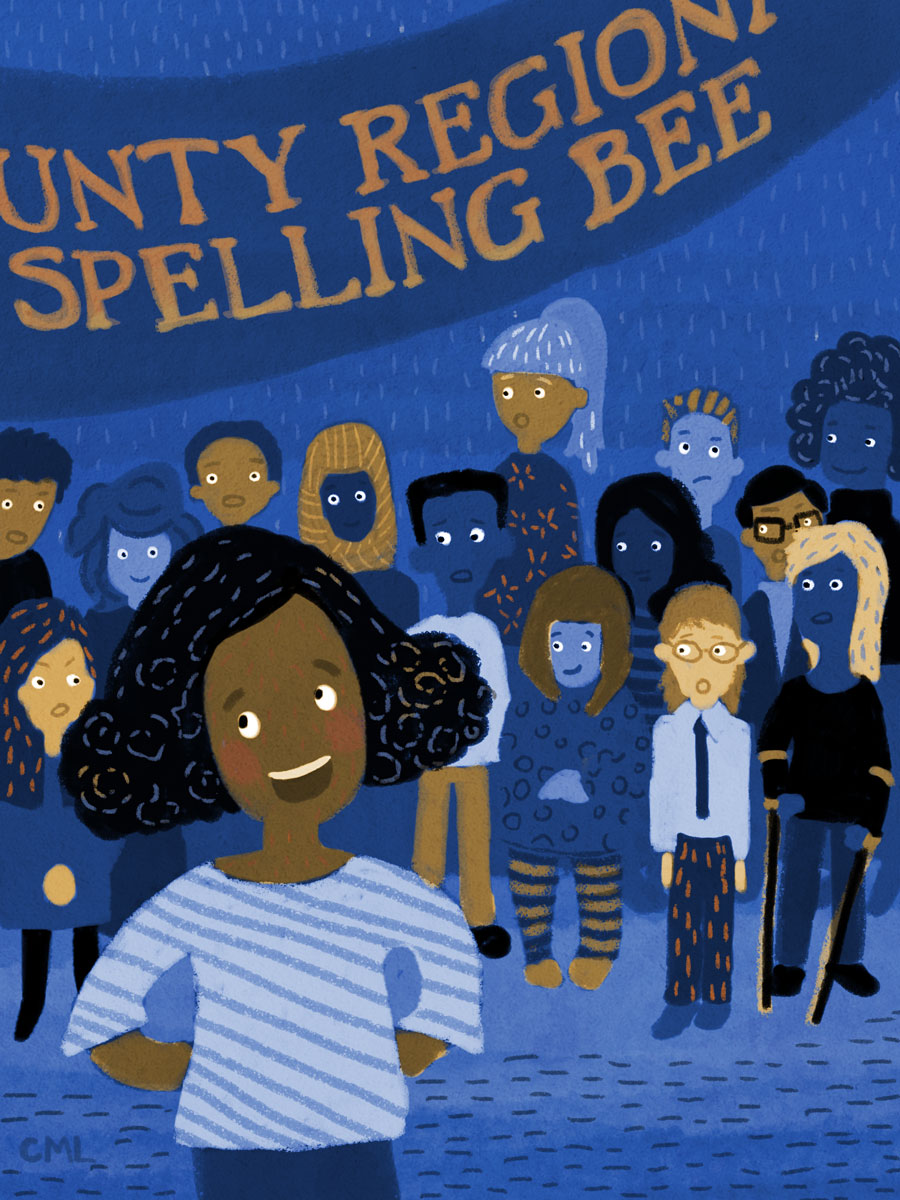
Sunday, March 25: King-Snohomish County Regional Spelling Bee
Exciting! Some 90 middle-schoolers join in M-O-R-T-A-L C-O-M-B-A-T to determine who is the best speller in the region. The winner will go on to face the best spellers in the country. Go get 'em, kids!
https://townhallseattle.org/event/king-snohomish-county-regional-spelling-bee-3/ Campion Ballroom at Seattle University, 914 E. Jefferson St, 12:15 pm, free.
Criminal Fiction: welcomes, congratulations and farewells
Every month, Daneet Steffens uncovers the latest goings on in mystery, suspense, and crime fiction. See previous columns on the Criminal Fiction archive page
Kicking off this month, the brand-new LitHub site, CrimeReads includes a monthly column from Sarah Weinman; congratulations are in order to Michael Connelly, winner of this year’s CWA Diamond Dagger; and finally, crime fiction loses a literary hero in Peter Temple.
Reading around: new titles on the crime fiction scene
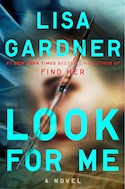
A family murdered nearly en masse, a missing teen and two determined women — one a cop, one a crime-survivor-turned-advocate-cum-avenger — make Lisa Gardner’s Look For Me (Dutton), a pacey, tautly-written mystery and quite the suspenseful humdinger. At its heart is not just a family story but a story about what makes a family, as well as a wonderful testament to the terrific work done by Court Appointed Special Advocates, the volunteers whose critical work protects children’s rights to a safe, healthy living environment.
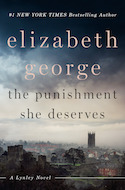
Elizabeth George’s latest Detective Lynley and Detective Sergeant Havers mystery, The Punishment She Deserves (Viking), begins with something a bit different. Havers is carted off by her superior officer and workplace nemesis, Detective Chief Inspector Isabelle Ardery, to the mellow Shropshire town of Ludlow to investigate the apparent suicide of a suspect in police custody. As the tension between the two detectives escalates — Ardery is determined to make this an open-and-shut case, while Havers’ detecting hackles hit the stratosphere as more and more odd characters and coincidences emerge — personal baggage takes over. Always terrific with her regulars’ private foibles and lives, George ups the ante here with multiple families all circling the drain of one particularly horrific set of crimes.
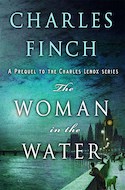
Murders on the Thames feature prominently in Charles Lenox’s origin story. In The Woman in the Water by Charles Finch (Minotaur), the 23-year-old Lenox — semi-party-boy by night, aspiring detective by day — is busy trying to establish his fledgling career and his foothold both in London’s social (read: disapproving) scene, and in the early (read: scornful) Scotland Yard. It’s enormously fun and emotionally engaging to follow Lenox, soon to become one of London’s redoubtable — if fictional — private detectives, as he navigates the murky depths of his first official case while grappling with one of life’s hardest lessons: “‘The hardest part of losing a person, Charles,’” as his father tells him, “‘is that grief is only an absence. There is nowhere to go to touch it. There is no cut that you can watch close over.’”
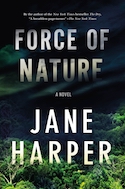
I loved Jane Harper’s The Dry, and Force of Nature (Flatiron) is an excellent follow-up. Federal Agent Aaron Falk and his partner Carmen Cooper, in pursuing their latest white-collar-crime case, have been engaging with a potential whistle-blower. When that whistle-blower goes missing during a corporate retreat in the Australian bush — in an area where a serial killer once stalked his prey, no less — the stage is set for a subtle thriller that combines a tense police investigation with the even more strained events leading up to the woman’s disappearance.
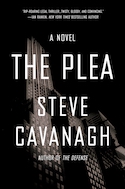
In Steve Cavanagh’s The Plea (Flatiron), lawyer Eddie Flynn, a former con artist, is tapped by the FBI to help them bring down a massive financial crime scheme, but it means treating possibly innocent people as collateral damage. Flynn, who has been blackmailed into acting on others’ behalf before, is no dummy, but he needs all his smarts for this wild ride. A nasty bit of murder, some dirty politicking, and some seriously twisted plot twists make this courtroom-dramatics-meets-con-game-antics a speedy and superbly satisfying read.
The Quintessential Interview: Eva Dolan
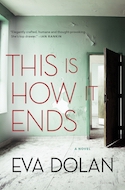
Eva Dolan’s terrific police procedural series featuring DI Zigic and DS Ferreira and their Hate Crimes Unit is a critical and well-respected hit in her native UK. Her US debut, This Is How It Ends (Bloomsbury), is a standalone mystery, addressing the accelerating — and socially damaging — gentrification of London, as seen through the eyes of two female activists who are trying to keep a partly-inhabited, low-income apartment building from being torn down.
What or who are your top five writing inspirations?
Anger is the big inspiration. Injustice. The desire to write about victims mostly ignored because they’re outsiders or at the ‘wrong’ end of the social spectrum. Wanting to do something different, even if it’s almost aggressively uncommercial. The sheer, bone-deep stubbornness of doing what I think’s right and balls to the consequences.
Top five places to write?
I would love to be the kind of writer who can work anywhere but I’m a creature of habit with very specific requirements when I sit down to actually type a book: that’s sitting on the sofa with my laptop on a cushion across my thighs. Despite the office I insisted on claiming, the lovely big kitchen table – where there’s also immediate access to coffee and biscuits – or the pretty Victorian library we’re lucky enough to still have in my nearest town and the welcoming 16th century coaching inn nearby, I couldn’t work in any of them. It’s the sofa for me.
Top five favorite authors?
Ian Rankin’s Rebus series is a huge inspiration — they were the first detective novels I read and were a template for how to write working-class crime fiction. In the same vein, John Harvey’s Resnick series really brought home to me how you can put social issues at the heart of a book and still make a compelling, driven narrative. Patricia Highsmith for psychological intensity. Cormac McCarthy for relentless commitment to the dark side. And Raymond Chandler for his depiction of sleaze in gorgeous prose.
Top five tunes to write to?
Vocal music is really distracting so I tend to go for stuff that’s mostly instrumental or, at least, unobtrusively vocal:
Anything by Mogwai, but The Hawk Is Howling is the album I listen to most often. Early Underworld, especially Second Toughest in the Infants. Massive Attack, all albums on repeat. Dirty Three have been a major find of the last few years, haunting, ethereal music underscored with a visceral sensuality — check out Horse Stories as a starting point — and in a similar vein, Warren Ellis’ and Nick Cave’s brilliant White Lunar.
Top five hometown spots?
I live in a tiny village without any amenities, so the place I tend to go most frequently is Stamford, a lovely market town a short drive away. It’s been voted the best place in the UK to live and it’s easy to see why: great restaurants and cafes, brilliant independent shops and some gorgeous Georgian architecture – fans of Jane Austen will have spotted it as the backdrop to the latest film version of Pride and Prejudice.
My bolthole there is The George Hotel’s gorgeous wood panelled and chestnut leather bar; the building dates back to the mid-10th century and almost hums with its history. I go here almost weekly for a pot of excellent hot chocolate and amaretto and tend to do a lot of my plotting in the lounge in front of the fire.
Another place steeped in history is the local Arts Centre, which has a beautiful ballroom where classes are held and a popular café serving great snacks. I’m also a big fan of its intimate little cinema, which shows classics and new movies in a very civilised setting.
This is becoming a theme but the Tobie Norris pub is a top choice for lunch and where I tend to take visitors. The menu is eclectic and always outstanding and the building itself is the quintessential English country inn, dating back to 1280, all nooks and crannies and history seeped into its stones.
Walkers Bookshop is a tiny independent which stocks a very respectable range for its size and also has a wide selection of chocolate for sale on the ground floor. I sneak in here for spur of the moment purchases and new Moleskine notebooks and to check if my friends’ books are in stock. They still don’t know I’m a local writer.
The Town Meadows is a small park in the fork of the River Welland and one of the most peaceful places in Stamford. When I was little my parents took us there to feed the ducks and the gaggle of aggressive geese which run the place. Now it’s a nice spot to pause and take a breath between the shops and a café, maybe play with one of the dogs which run around the grass there. I’m a sucker for other people’s pooches.
Book News Roundup: Tired of writing? Try writing near tires.
Did you know that you can help young users of the Seattle Public Library "regain access to the Library's resources by paying for borrowed materials that were misplaced or lost?" Yep! Help a kid get a fresh start through the Seattle Public Library Foundation's Fresh Start page.
Last week, the National Book Foundation announced the judges of their 2018 National Book Awards. This year, the Foundation is introducing a new award for translated literature, and there's a Seattle connection to the new category. Elliott Bay Book Company events coordinator Karen Maeda Allman is one of the five translated literature judges, which means she's going to be reading a whole lot of work in translation over the next few months. Congratulations to Karen!
Donald Trump is good for the feminist bookstore business.
Readers are more creative and successful, according to a new study. But you already knew that.
Here's a great look at gender equality and cartooning from New Yorker cartoonist Liza Donnelly:
The AV Club looks back on the big mystery that was the secret identity of the anonymous author of the Bill Clinton roman á clef Primary Colors. For one brief moment in 1996, all of America was trying to figure out who wrote a novel about politics, of all things.
This tire shop that helped a writer overcome writers block really ought to consider making a title of "Official Tires Tires Tires Writer in Residence."
Thursday Comics Hangover: The personal touch
Now that Facebook is burning down, maybe it's time to learn how to interact with other people again. Maybe you should try to figure out how to write letters. Maybe you've fallen so into the habit of bragging on social media that you don't remember how to tell people honestly about how your day was, or what you think or feel about things. Maybe we all need to learn how to communicate again.
This week, I've been reading Small Careful Fires, a collection of non-fiction comics by Seattle cartoonist Katie Wheeler. They've helped me feel more human in a week when the news is making me feel like nothing more than a predictable set of consumer choices on some website somewhere.
Fires is a collection of strips that read like diary entries. They're little moments, captured and curated with care: Wheeler cooks lunch, she goes to yoga, she and her husband consider adoption. Wheeler's art is intimate and warm. On every page, she letters with a blend of print and cursive that delivers a handwritten vibe.

Some of Wheeler's panels are descriptive, showing the plants in her apartment in close detail. Other panels are more abstract, depicting her anxieties as an ominous doorway to "a room of worries in [her] mind." A few panels are crammed full of words, like when someone tries to tell you a story they're so excited to share that they start talking really quickly.
Wheeler uses color to great effect in Small Careful Fires. Each anecdote is told in shades of a single color. The strip about anxiety is laid out in shades of blue, the strip about tending plants is green. The color creates an atmosphere for each story, giving each turn of the page some added excitement.
Reading Small Careful Fires in this exact moment was important for me: it reminded me that there's more to communication than what we can cram into Facebook's text boxes. Wheeler's autobiographical strips are so open and funny and inspirational and inviting that they'll make you want to share something of yourself, too — something real. Something human.
On negative reviews and why The Scarlet Letter is still relevant
Over at Literary Hub, the Book Marks team interviewed me for their "Secrets of the Book Critics" series about literary criticism, why I couldn't read fiction for a year after Donald Trump was elected, and much more:
BM: What is the greatest misconception about book critics and criticism?
PC: That negative reviews are a bad thing. It’s important for a critic to write and publish negative reviews so that their readers can get a complete sense of what their tastes are. And it’s important to be able to speak freely and frankly about art—that means both positively and negatively. Unthinking boosterism doesn’t help authors improve, it doesn’t help literature stay strong and interesting, and it kills the ongoing conversation that is art.
So to writers and agents and publishers who feel personally injured by negative reviews, I want to say: You’re strong enough to take some constructive criticism. It’s okay. And I suspect that a well-written negative review is more likely to drive readers to a book than a poorly written positive review, anyway.
A wolf at the door
Published March 21, 2018, at 12:00pm
In Calling a Wolf a Wolf, Kaveh Akbar asks us to "to fold the darkest and twistiest parts of ourselves into the larger experiment of humanity," says Dujie Tahat.
Talking with Julene Tripp Weaver about her path to poetry and her poetry idols
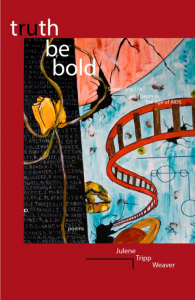
Our March Poet in Residence, Julene Tripp Weaver, is right now having a moment. This month, she's reading multiple times all over the region and her most recent poetry collection, Truth be bold — Serenading life & death in the age of AIDS was nominated for a Lambda Award. She's squeezing more activity into the month of March than most poets in Seattle manage to do in a year. But Weaver isn't an overnight success; she's been quietly putting out and reading quality work in Seattle for a couple of decades, and she'll keep writing and reading even when the spotlight moves to another poet for a while. Weaver was gracious enough to make some time to talk with us about her career, her moment, and what's next.
I've known you for more than 15 years now! You used to read at the open mic I hosted at Elliott Bay Book Company from 2002 to 2008. Even then, you seemed like a confident and talented poet.
When I lived in New York, I did readings. After moving west, because of the process of resettling and going back to school for my Masters, readings were not a priority. But I was writing - mostly in my journal. At a birthday party I attended, a biker made a statement: "If you're a biker you've got to ride." I translated that sentence to, "If you are a writer, you've got to read."
It was one of those light bulb moments, and I started reading publicly again in May 2002. Elliott Bay was my favorite venue because of your gracious hosing style: inclusive, supportive, fun, and welcoming to anyone who wanted to read. I appreciated that it was a full range of literature, not simply poetry, and that your venue in Pioneer Square created a community. The two highlights for me was the haiku challenge you sponsored and subsidized, and during intermissions when you read your writing. I met so many people I am still in touch with at those open mikes. Your nurturance of writers and independent bookstores is a gift you give to Seattle.
That's unbelievably nice of you. Thank you. Can you talk a little bit about your journey into poetry?
My undergraduate is in Creative Writing, with an emphasis on Poetry, from the City University of New York, I primarily chose Hunter College to study with Audre Lorde; but the City University of New York (CUNY) also gave me the opportunity to study at Brooklyn College with Joan Larkin. This was back in the early 80s and I was returning to school for writing because my early desire to write was squelched by family and circumstances. I had to leave home, and had a career as a laboratory technician for fourteen years. When I moved to Seattle, I went back to school for a Masters in Family Therapy, so my first years living here were full.
In 2016, Dustin Brookshire, a poet who edited a journal in Atlanta, invited me to write a piece about my writing history for his blog.
Your poetry seems, to me, to be inextricable from the work you did for many years as a medical HIV/AIDS case manager.
Do you think poetry helped you cope with what must have been a very difficult job?
Yes. I worked in AIDS services for 21 years, 18 of them as a case manager, and writing helped me with the work because any social work evokes secondary trauma, and writing is healing.
This job was a perfect fit because I was in a Family Therapy Master of Arts program at LIOS (Leadership Institute of Seattle), and was looking for work that was meaningful. I wanted to work with people living with HIV/AIDS because I knew I was positive. This job gave me an opportunity to serve a community I was part of and to learn as much as possible, which was one of my goals for self-preservation.
At Hunter, Professor Louise DeSalvo, PhD, became a strong mentor. Two of her books, Writing as a Way of Healing: How Telling Our Stories Transforms Our Lives, and The Art of Slow Writing, document a psychological study by James Pennebaker, which show that writing heals trauma. In my private practice, I use writing as an assignment to create a new narrative, and to ease loss and grief. There are many interests I've pursued that inform my writing, self-healing, and therapy practice: dreams, body work, herbal and alternative medicine, which I use for myself and with others toward healing.
Do you think your job provided necessary inspiration as a poet?
The work provided a very rich field for persona poems, elegies, and to process emotions and experience. At that time, I was writing for the Health Corner Column, a newsletter for the Babes Network, a peer support organization for women, which I helped found. I wrote articles on how to support the immune system using prevention with food and herbs.
My first AIDS poem came to the page in a Continuum Movement Poetry in Motion Intensive in 1996. The AIDS poems flowed out of me after that intensive, so yes, my work inspired much writing. But I also write on other topics. My second book, No Father Can Save Her, is autobiographical, with many poems on growing up in New York City during the sexual revolution, interracial relationships, grief from the loss of my father, and mental illness.
I believe there are wells inside us to be uncovered. When my mother died last year, I wrote many mother poems; after I traveled to Istanbul I wrote about that experience, my poem "Istanbul Secrets" won 2nd Prize in the InterBoards June 2015 contest, judged blind by Lesley Wheeler; another poem was published this year in the Bosphorus Journal, an English language Turkish journal. Any experience provides fodder for a poet or writer.
Who do you like to read?
Reading has been one of my favorite indulgences since childhood. To make a list in different genres would be way too long, and miss too many good writers, so I'll just give a recent book or so in each category. There are so many excellent writers.
Poets: Most recent is Tara Hardy's book My, My, My, My, My. Before that I read Lana Hechtman Ayers, The Four Quarters, an homage to T.S. Eliot's Four Quartets; Tina Schumann's Requiem a Patrimony of Fugues; and Jesse Minkert's chapbook Rookland.
I'm working on a memoir and love to read about people's lives. I'm slowly reading Why We Write About Ourselves: Twenty Memoirists on Why They Expose Themselves (and Others) in the Name of Literature, edited by Meredith Maran. This is a topic I think about a lot with my recent book revealing my status for the first time publically. Also, David Wojnarowicz's Close to the Knives: A Memoir of Disintegration, and Tom Hansen's American Junkie. Earlier, Elizabeth Alexander's The Light of the World, which was incredible.
For fiction, Kiese Laymon's Long Division; John Treat's The Rise and Fall of the Yellow House, set in Seattle about the early AIDS epidemic; I discovered Richard Wagamese when I visited a friend in Canada and read Ragged Company; I'm looking forward to Amber Dawn's new novel, Sodom Road Exit; and of course anything by Tom Spanbauer or the Dangerous Writers.
And for essays, Mary Ruefle's Madness, Rack, and Honey and Mary Gaitskill's Somebody with a Little Hammer.
In fall 2017, I read along with a class syllabus! Professor Patrick Horrigan taught my book in an English Honors class at Long Island University-Brooklyn. The class, "How to Survive a Plague: Art and Literature in the Age of AIDS," used David France's book, which I had already read. I am deeply honored that my book was taught alongside his. I met with the class through Skype for an hour and forty minutes to answer their 27 questions, which were sent to me in advance. After our time ended, they had more questions, so I responded with a letter. This semester he is teaching, "You Always Hurt the One You Love": A Survey on American Literature, and using individual poems from my book next to Walt Whitman poems written in 1865, when he nursed injured Civil War soldiers. My case management experience during the epidemic is comparable.
I read many books about HIV/AIDS and gay history. Mattilda Bernstein Sycamore's That's Revolting!: Queer Strategies for Resisting Assimilation; Martin Duberman's Hold Tight Gently: Michael Callen, Essex Hemphill, and the Battlefield of AIDS.
For psychology books: I have studied Sensorimotor Psychotherapy. A few authors I've read extensively are Pat Ogden, David Siegel, and Stan Tatkin.
I am active on Goodreads, recording and commenting on books. I mark as "to read" far more books than I'll ever have time to finish. It is a resource that helps me remember books and helps me focus. Like most readers, I have a pile of books waiting to be read and a constant urge to buy more. I've been using the library lately and have stopped cold turkey going to the Friends of the Library sales. With so many writer friends it is hard not to buy books.
You're having a very busy month this month! Can you tell us a little about what you're working on?
This past year I have been busy promoting my book, which came out in April 2017. I gave many readings including one in New York City at the Bureau of General Services-Queer Division, housed in the Lesbian and Gay Center, which is where the LIU professor heard me read. This month I had three readings: one a webinar for Women and Girls HIV/AIDS Awareness Day, one at Soul Food Books for the Ice Cream Anthology, and one at Open Books with Tara Hardy. On April 26th I will read in Portland, OR, at Another Read Through bookstore with Penelope Scambly Schott, and Christopher Luna. Later this summer, July 7th, I will host an Ice Cream Anthology reading at Poetry in the Park (Marymoor).
This year I sent my book out to contests, which has been expensive but fruitful. My book is a Finalist for the Bisexual Book Awards, and for the 30th Annual Lambda Literary Award. I'm heading east to attend these two gala events. As a native New Yorker, I'm always thrilled to go back east. Also, it is nominated for The Golden Crown Literary Society Awards.
Truth be bold is a beautiful book with good poetry and a stunning cover. The art is by Duane Kirby Jensen, whose art also graces my second book's cover. I'm grateful to have the perfect art to match my words on all three of my books.
I'm in two writing groups. One has been ongoing since 2003 after a Tom Spanbauer week at Haystack in Cannon Beach, Oregon. We bring prose pages for feedback, which we read out loud; and I am in a poetry critique dyad with a poet who was part of a long-term poetry group. The group dissolved when several members moved.
As my current book promotion energy shifts, I will work on my memoir and pull together another poetry manuscript from my body of published and unpublished poems, diving into the process to find the themes and arch that makes a book. So, I have two more books to develop.
Do you see a difference between the performance of poetry and the writing of poetry, or do you write the pieces to be read aloud?
Writing is a physical act, it is embodied, so I read my work out loud. Writing is meant to be voiced and heard. When I revise I read my poem out loud over and over to get the rhythm coming through that particular poem. After I did my first "Poetry in Motion" movement intensive I loved it so much I ran workshops for ten years including a series at Cancer Lifeline. So yes, writing poetry is connected to the verbal: in the workshops, breath and audible breath (sound) is used to alter our internal space and then see what evolves. It is hand-to-page work so the line and images are as important as the writing that comes because in is energy in the body that is moving.
Do you have any performance idols?
My performance idols are Patricia Smith, Anne Devere Smith, and Tara Hardy. I took a performance workshop with Tara at a Poetry in the Park years ago.
Before I left New York, an actor friend coached me in reading to an audience. I appreciate feedback to improve my readings, and believe writers needs oratory skills to do their work justice. I remember the first time I read at Elliott Bay you commented that I had reading skills. And I did. I do not take reading my work lightly because it is how the work is felt, people need to hear it and respond at a gut level. Audre Lorde would ask after someone read, "How do you feel?" I'm aware I can improve, I tend to have a low voice, so I prefer to read with a microphone.
I'd encourage you to read this whole Twitter thread by Shannon Hale about authors who are horrible in public:
Here's a little story I've told often in private but never in public. Several years ago I was the emcee of a high profile author event.
— Shannon Hale (@haleshannon) March 19, 2018
For the love of God, authors: everyone has a megaphone now. If you can't act like a decent human being because it's the right thing to do, you should at least act like a decent human being because the world will very likely learn about your behavior.
Never forget, never forgive
Published March 20, 2018, at 12:01pm
Jennifer Natalya Fink reads from her remarkable novel at Elliott Bay Book Company this Friday. It's about the way we forget all the tragedies that make us into who we are, and how that's maybe the biggest tragedy of all.
Rusty Chain Heritage
The antique cards from my great grandmother,
the photographs of ancestors I did not know,
so much regal furniture, I sat in a closed off
parlor, quiet in a King George chair, lookedacross the room at the matching couch,
the grand organ, the gold trimmed tall mirror
with marble at its base, hung full length
between tall windows formally draped.I loved the quiet in this room, the history I
never understood. The organ no one played,
out of tune, a museum for far away relatives
in England or Holland, mother’s sideof the family, who tried to stay wealthy
but exposed to the elements oxidized
in a slow decline, till it wore thin this family
chain, clear to inevitable death.So much no one remembers, only two chairs
left, reupholstered, and the mirror, yes, the
mirror, now on sister’s wall in Philadelphia,
no longer with its marble stand, but it hangsa view to see ourselves, how we have walked
through to this other side — some of us — who
would be us, long disappeared, those still here
with traces in our blood, on our walls, in thepictures we grow older and more distant
every decade — this rusty chain still present —
binding like a cross, there is no escape, no matter
the life we live now.
Mail Call for March 19, 2018
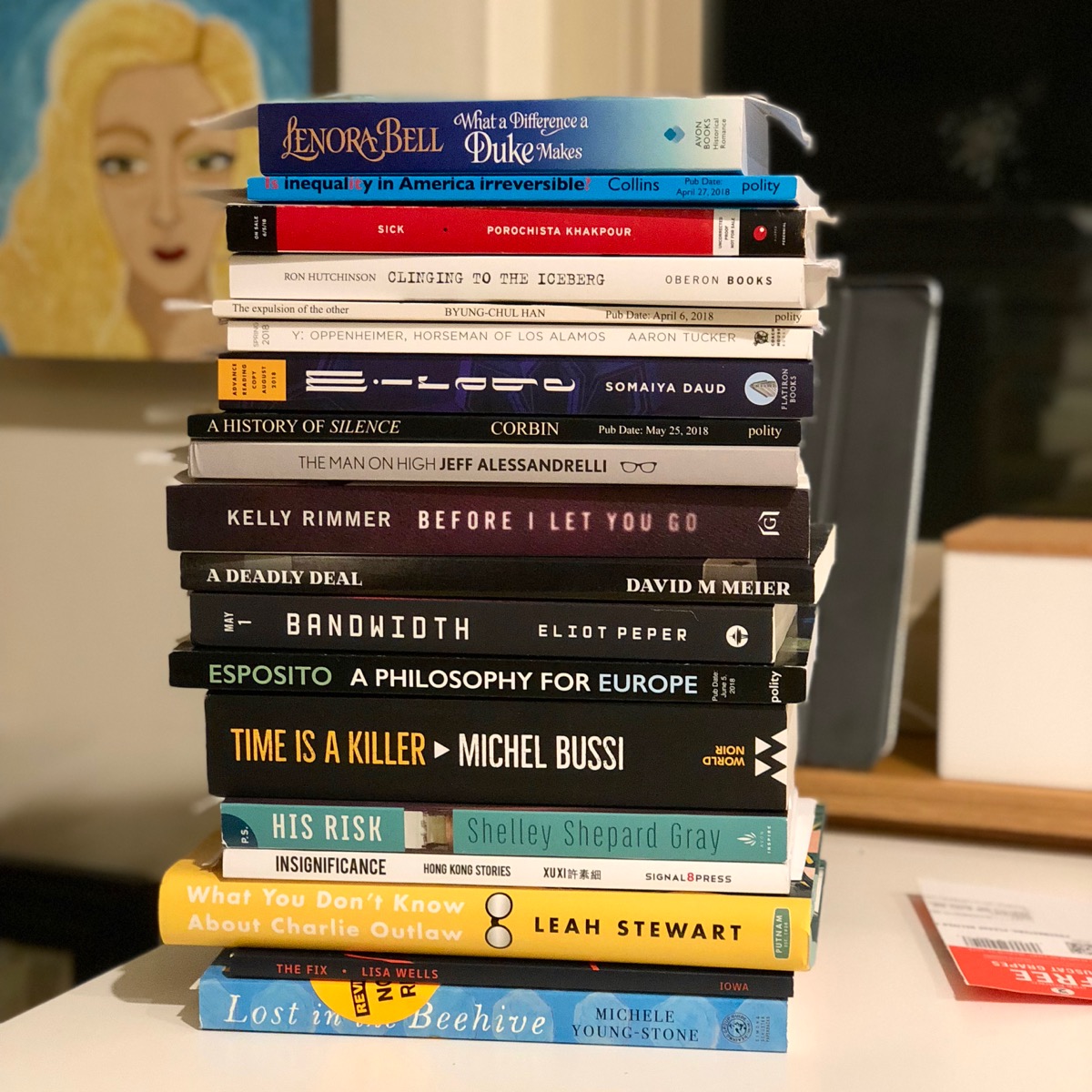

The Seattle Review of Books is currently accepting pitches for reviews. We’d love to hear from you — maybe on one of the books shown here, or another book you’re passionate about. Wondering what and how? Here’s what we’re looking for and how to pitch us.
Get a peek at Janet Buttenwieser's new memoir

Hop over to our sponsorship page and check out the prologue, which Janet has generously shared with our readers this week. And join her at Elliott Bay Books on March 31, when she takes the stage with fellow Seattle7Writers Sorting Room Residents. We love when Seattle authors sponsor the site, and we're delighted to offer you a few pages of good reading to make your Monday brighter.
Sponsors like Janet Buttenwieser make the Seattle Review of Books possible. Did you know you could sponsor us, as well? If you have a book, event, or opportunity you’d like to get in front of our readers, reserve your dates now.
Your Week in Readings: The best literary events from March 19th - March 25th
Monday, March 19: The Dark Corners of the City: Literary Murder in Seattle
See our Event of the Week column for more details. Third Place Books Lake Forest Park, 17171 Bothell Way NE, 366-3333, http://thirdplacebooks.com, 7 pm, free.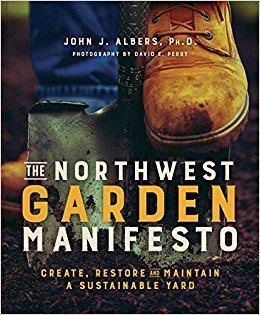
Tuesday, March 20: The Northwest Garden Manifesto Reading
John Albers puts more than 30 years of Northwest gardening experience to work in his latest book, which will help you make your surroundings more of a genuinely Northwest landscape. Alberts is interested in environmentally sound gardening procedures and keeping gardens regionally appropriate.
Third Place Books Ravenna, 6504 20th Ave NE, 525-2347 http://thirdplacebooks.com, 7 pm, free.
Wednesday, March 21: Happiness Reading
Aminatta Forna's latest novel, Happiness, is about an American woman who goes to London to study the habits of urban foxes and who encounters a psychiatrist from the west African nation of Ghana. It's a book about coincidences and happenstance and serendipity. Seattle Public Library, 1000 4th Ave., 386-4636, http://spl.org, 7 pm, free.Thursday, March 22: Sacred in the Everyday
Seattle poet Shin Yu Pai appears in conversation with zen teacher Peter Levitt, who has written 14 books. Levitt will share some of his most recent poems and then he'll talk about zen and poetry and teaching with Pai, who knows quite a bit about poetry and about thinking deeply about the world. Phinney Neighborhood Association, 6532 Phinney Ave N, 7:30 pm, free.Friday, March 23: Bhopal Dance Reading
Jennifer Natalya Fink's latest novel imagines a world in which corporations can pollute and destroy the environment with almost no repercussions. Ha ha ha. Crazy, right? Of course it's fiction. Fink will appear in discussion with Seattle author Mattilda Bernstein Sycamore Elliott Bay Book Company, 1521 10th Ave, 624-6600, http://elliottbaybook.com, 7 pm, free.Saturday, March 24: Baby Story Time
It's never too early to start enjoying stories. The High Point branch of the Seattle Public Library hosts this reading of stories and poems aimed at Seattle's youngest book aficionados Seattle Public Library, High Point Branch, 411 SW Raymond St, http://spl.org, 11:30 am, free.Sunday, March 25: King-Snohomish County Regional Spelling Bee
Exciting! Some 90 middle-schoolers join in M-O-R-T-A-L C-O-M-B-A-T to determine who is the best speller in the region. The winner will go on to face the best spellers in the country. I took part in a spelling bee in elementary school; I went on to regionals and then I lost because I spelled "VENEER" "V-E-N-I-E-R." I guarantee that several of these kids are going to remember the words they lost on for the rest of their lives, too. Campion Ballroom at Seattle University, 914 E. Jefferson St, 12:15 pm, free.Literary Event of the Week: Literary Murder in Seattle at Third Place Books
We look to novelists to inspire us, but we also look to them to tweak the ugliest parts of our imaginations, to invent the unimaginable, to speak the unsayable. It's not that humans are inherently bad, exactly. We're just inherently fascinated by bad behavior. That's why the Devil - with a little more than a glorified cameo - became the sleeper favorite character of the Bible. We like to think about terrible things, and then we like to put the book down and resume our ordinary lives.
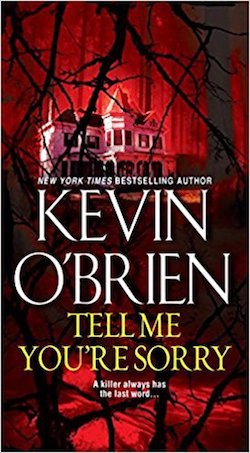
According to Third Place Book's press materials, the two will take part in "a fun and participatory conversation about the best REAL places in and around Seattle to kill someone (fictionally)." Where in town would you be able to kill a person without someone else overhearing? Where would you be able to hide a body? Is there a spot around the Duck Tours route that would be better for murder than any other?
This is a great idea for an event: put two experts together - one Seattle geography expert, one fictional murder expert - and let them riff on the spot where their Venn diagrams mesh. I'd love to see more bizarre literary pairings like this. Why not imagine all the fictional ways you can enjoy Seattle? Why not incorporate sci-fi authors, cookbook authors, historians, and juxtapose them in thrilling ways? I bet people all over Seattle are - forgive me - dying for an event like this.
Third Place Books Lake Forest Park, 17171 Bothell Way NE, 366-3333, http://thirdplacebooks.com, 7 pm, free.
The Sunday Post for March 18, 2018
Each week, the Sunday Post highlights a few articles we enjoyed this week, good for consumption over a cup of coffee (or tea, if that’s your pleasure). Settle in for a while; we saved you a seat. You can also look through the archives.
Does recovery kill great writing?
Move past the Bettridge-y headline and dig straight into this essay by Leslie Jamison on the relationship between booze and books — or, more accurately but less pithily, on giving up booze while continuing to write books. She walks briefly with Berryman, Jackson, Wallace, and Johnson, digging into the recovery writing of each while tracing her own journey away from alcohol. If your writing self is built around drinking, how do you find a road to the new writer you’ll have to become when you stop?
Once I got sober, I became more interested in the question of what little, as Berryman put it, could be said for sobriety. If addiction stories ran on the fuel of darkness — the hypnotic spiral of an ongoing, deepening crisis — then recovery often seemed like the narrative slack, the dull terrain of wellness, a tedious addendum to the riveting blaze. I wasn’t immune; I’d always been enthralled by stories of wreckage. But when I got sober, I wanted to know if stories about getting better could ever be as compelling as stories about falling apart. I needed to believe they could.
A Midwestern High Schooler’s Intimate, Imperfect Portrait of Adolescence
I’ve been dancing around this one — it’s already been covered by both the inimitable Jason Kottke and the head-spinningly peripatetic Matt Muir — but I’m surrendering: have you looked at Colin Combs’s Instagram feed? The Ohio teen flawlessly captures what a friend who grew up a little bit in Eastern Washington, a little bit in rural Virginia, called “that backwater aimlessness.” Or maybe it’s just the inner landscape of every teen (and a lot of grown-ups), perfectly externalized.
The first camera that Powell offered her pupil was a bulky teal Minolta, which, at the time, matched the shade of his hair dye. Last summer, as always, Combs was wearing a similar model around his neck when an S.U.V. struck him while he was skateboarding, breaking his leg. “I took photos of my foot pretty much right after,” he said, ever ready to render the moment. Combs needed surgery, but his film survived.
As a second take on the ravishing image, here’s the output from a drawing class that brought Iggy Pop in as live model. NSFW, if you work in the wrong sort of place.
J.G. Ballard’s Eerily Accurate Dystopias
In a round up of two recent J. G. Ballard re-releases — Crash and Super-Cannes — Becca Rothfeld points out that Ballard held up a black mirror to the present long before the present arrived. A very uncomfortable look at who we are, or who we might become if we don’t get our eyes back on the road.
Reviewers have often called Ballard’s dystopian visions “prophetic”: He foresaw self-driving cars, Uber-style ridesharing, and the lavish corporate campuses where life and labor blur into one another. But perhaps his canniest forecast was that comfort would prove so lethally uncomfortable.
The Billionaire Philanthropist
This is a short read about our city’s richest non-philanthropist, that’s also an interesting poke at the underpinnings of wealth in America, and its ugly divorce from the social good.
Don’t let the title fool you. Jeff Bezos is notoriously reluctant to take a seat at the table with Warren Buffet and Bill Gates. He deserves to be called out for it, and Jacob Silverman capably does so. But Silverman also asks for something more than philanthropy from today’s financial titans: a practical application of their talents (and funds) to rebuild our social fabric.
Unfortunately, that rebuilding would undercut the systems that allow ungainly accumulation of wealth in the first place. But if Bezos ever gets tired of running a vast engine of inequity — while playing at rocketships with the other super-rich kids — maybe he could give it a try?
Today’s moguls are charitable but "results-driven." They speak of leaning in but not, in any meaningful sense, of social justice. Believing existing political institutions to be clumsy and inefficient, they dispense vast sums of money toward “innovative” solutions that invariably devolve public services into private companies (Amazon, for instance, sponsors a homeless shelter in Seattle). What they cannot abide, or simply don’t know, is that many of the answers to our problems were discovered by post-war social democracies seventy-plus years ago.
If you’ve had enough of Amazon.com, try this piece on the impact of bitcoin mining in Eastern Washington and similar areas: spaciously rural, proximate to electricity, environmentally and economically vulnerable. The Cloud isn’t really a cloud — it has to live somewhere. This is what that looks like, both good and bad.
Welcome to the Center of the Universe
In case you think I don’t like rocketships (I do, so much), here’s an article about them that gave me great joy and will make you happy too. Shannon Stirone embedded with the crew that runs the Deep Space Network, the comms command center that keeps Earth Central in touch with the space stations and satellites that explore the stars for us. Imagine that vast cold vacuum against a satellite’s metal skin, and the tiny voice that connects it always to home — these guys make sure that voice never goes silent.
McClure is nervously tapping a stack of round CENTER OF THE UNIVERSE stickers on a table. “The data is always stored, so it’s fine,” he says, trying to reassure me. “Once it hits the ground it’s stored.” The staff speaks to one another like doctors in an emergency room moments before attempting to jump-start a quiet heart. “Okay, trying to reconnect now.” The data controller grabs the paddles. “Not getting anything. Nothing. Trying again.” The Cassini Mission ACE, the liaison between Earth and the spacecraft, rushes in, his messenger bag slung over his shoulder, and mumbles something to McClure. He hurries to his station, lit up in neon blue, past the barricade with a homemade sign that reads, DO NOT FEED THE ACE — TO THE WOLVES. He plops his bag onto the floor, hunches over his desk, taps the keyboard, and begins trying to talk to Saturn.
Whatcha Reading, Mattilda Bernstein Sycamore?
Every week we ask an interesting figure what they're digging into. Have ideas who we should reach out to? Let it fly: info@seattlereviewofbooks.com. Want to read more? Check out the archives.
Mattilda Bernstein Sycamore is the Seattle-based author of the Lambda Literary Award winning The End of San Francisco, and the upcoming novel Sketchtasy, coming in October from Vancouver's Arsenal Pulp Press. She'll be appearing in conversation with Jennifer Natalya Fink next Friday, March 23rd, at the Elliott Bay Book Company. And, she's promised a preview of Sketchtasy at the event!
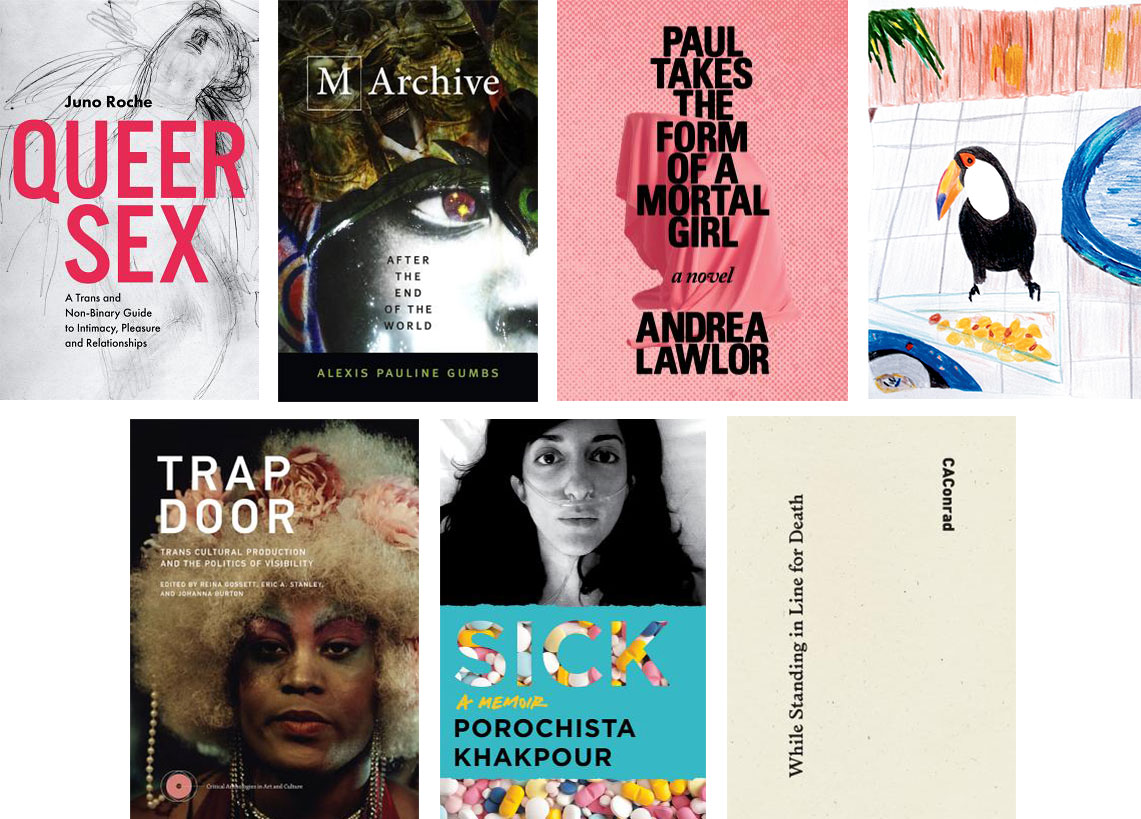
What are you reading now?
I’m reading Queer Sex: A Trans and Non-Binary Guide to Intimacy, Pleasure and Relationships by Juno Roche. I’ve only read the intro so far, but what I love about it is that Roche tells us right away that she hasn’t been having sex at all, which immediately flips the expectation of any guidebook, right? In fact, in spite of the subtitle, Roche says this isn’t a guidebook at all, but “a book in which I hope to honestly lay myself bare and share stories and experiences from others and to celebrate the potential of our wonderful bodies and lives.” Sounds exciting to me — I’ll be writing about this book for Bitch, so I’m sure I’ll have more to say soon. Stay tuned!
What did you read last?
Is it weird that I can’t remember what I read last? I mean I know I read M Archive: After the End of the World by Alexis Pauline Gumbs, because I just interviewed her about the book for BOMB, but also I know that I let myself sit for months in the intersections that the book opens up, from “our bodies were like landfills, places where nothing disintegrated but us” to “the task of believing there was some possible relation that wouldn’t mean detonation” and back, before coming up with my questions. And, before that, I read Paul Takes the Form of a Mortal Girl by Andrea Lawlor, where the shape-shifting Paul asks “What was sex but newness?” while shifting body to meet desire, or is it desire to meet body? The book takes place in 1992, when binary gender still reigns supreme in queer worlds (even in the questioning of it), but Paul, due to special powers, manages to inhabit every side, and does this mean freedom or claustrophobia, inclusion or implosion?
What are you reading next?
Honestly I always have trouble deciding.... Just yesterday, the fifth and final issue of the Semiotext(e) journal ANIMAL SHELTER arrived in my mailbox (I have a piece in it called “A Sense of Belonging,” an excerpt from a new book I’ve been working on called The Freezer Door), and the gorgeous colorful cover featuring a drawing of a toucan balanced on a table or a roof or wherever it is it’s beckoning to me, as is the range of brilliant writers and artists inside. And, speaking of brilliant writers and artists, there’s Trap Door: Trans Cultural Production and the Politics of Visibility, an instigation disguised as an art book, edited by Reina Gossett, Eric A. Stanley, and Johanna Burton — I open right to a photo of a banner that reads “CAPITALISM IS FUCKING THE QUEER OUT OF US,” hanging from the scaffolding of a building along the pride parade route in San Francisco in 2012, and then browse through decades of images of trans and queer resistance. And then there’s Porochista Khakpour’s Sick, which I’ve been craving for a long time, since I, like Khakpour, have struggled for years with debilitating chronic health problems, and I know that Khakpour’s memoir about Lyme disease will challenge simplistic media narratives about conquering illness that offer false hope and disempower those of us who are really always struggling, right, we are struggling! And don’t let me forget CAConrad’s While Standing in Line for Death, which starts with “Yes poetry can handle this.” Yes!
